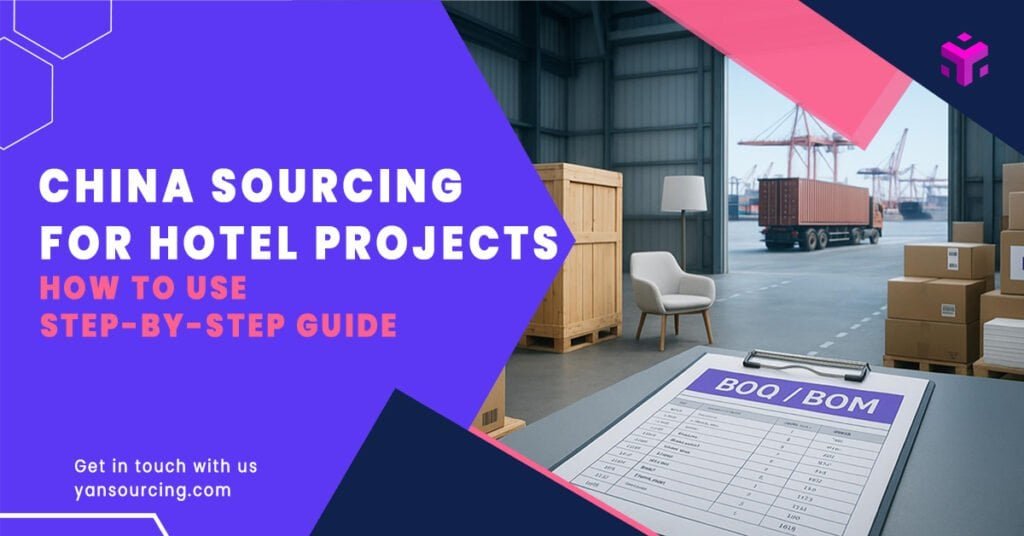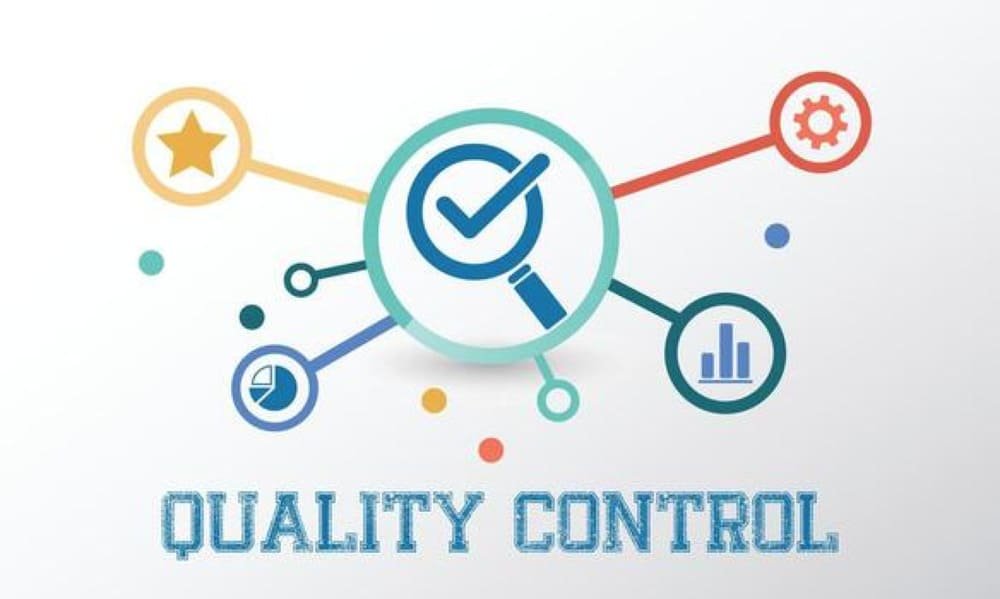
When you’re staring at a project pack that touches dozens of suppliers across FF&E, OS&E, and building materials, it’s not just complexity—it’s interface risk. Budgets slip, opening dates wobble, and compliance gaps surface late.
Here’s the deal: you can run China as a one-stop source with a single program that bakes in compliance, QA/QC, and consolidation from day one.
Step 1: Package your scope for a one-team program

Start with the document that drives everything: a clean BOQ/BOM, organized by room type and zone (e.g., King, Twin, Corridor, Lobby, Back-of-house) with each line item traceable to drawings and specs. Think of it as your master key—the better the structure, the smoother every downstream step.
Across categories, most hospitality programs will cover FF&E (casegoods, seating, lighting, mirrors, art, window treatments, rugs), OS&E (linens, small appliances, kettles/irons, tableware, guestroom accessories), and building materials (tiles/stone, sanitaryware, hardware, switchgear, interior doors). Define first-article approvals and retain control samples from the start.
Specification hygiene: lock down final elevations, finish schedules, edge details, metal gauges/coatings, upholstery grades, and performance requirements (fire/emissions, IP ratings, impact resistance where relevant). The clearer your spec, the fewer change orders you’ll fight later.
What to source in China versus locally? Most FF&E, OS&E, tiles/stone, sanitaryware, decorative lighting, hardware, and millwork assemblies are strong China candidates. Consider local sourcing where jurisdiction-specific life-safety approvals are non-transferable or where perishability/urgent replenishment dominates.
Step 2: Build your supplier matrix by category and cluster

China’s clusters simplify shortlisting: Foshan/Shunde for furniture and stone, Zhongshan/Shenzhen/Dongguan for lighting/electronics, Ningbo/Jiaxing for hardware.
For each category, your matrix should capture legal status and capacity (license check, ISO 9001, throughput), engineering depth (CAD, jigs, tooling ownership), compliance evidence (historical reports and willingness to test), and commercials (MOQs, lead-time ranges, payment terms, spares/warranty).
Run samples and first articles early. For textiles/drapery, require swatch testing before yardage. For composite-wood casegoods, align emissions documentation to U.S. TSCA Title VI or EU E1 (details below). For electrical items, agree the certification route before tooling to avoid rework.
Step 3: Lock the compliance plan (fire, emissions, electrical)

Establish which standard applies to each item type and specify acceptable evidence in your contracts. Don’t rely on brochures; require accredited lab reports for the exact SKUs.
| Item type | Primary standard(s) | Evidence to request |
|---|---|---|
| Curtains/drapery, decorative textiles | NFPA 701 (US); BS 5867-2 Type B/C (UK/EU) | Accredited lab report to the applicable method; consider production-lot retests if FR treatment is used. Scope notes at NFPA 701 (NFPA catalog) and BS 5867-2 (BSI catalog). |
| Building materials (e.g., wall panels) | GB 8624 combustion classification (China) | Accredited report stating the GB 8624 class for supplied materials; use official identifiers. See an overview for GB 8624 classification. |
| Composite wood in furniture/casegoods | U.S. EPA TSCA Title VI ppm limits; EU E1 via EN 717-1 | EPA-recognized TPC certification/labels; chamber test report for EN 717-1 E1. See eCFR 40 CFR Part 770 (TSCA Title VI) and a technical synopsis of E1 and the 2026 EU REACH limit. |
| Electrical lighting/appliances | U.S.: NRTL mark (UL/ETL/CSA); EU: CE (LVD/EMC/RoHS); UK: UKCA; CN: CCC (where applicable); IECEE CB Scheme | Certification plan by market; CB Test Report if using IECEE; Declaration of Conformity for CE; label artwork. See OSHA’s NRTL program and the EC overview for CE marking and directives. |
Practical notes: TSCA Title VI emission limits include HWPW 0.05 ppm; MDF 0.11 ppm; thin MDF 0.13 ppm; particleboard 0.09 ppm—cite categories in contracts using the eCFR reference above. For UK projects, verify UKCA guidance, and for Chinese domestic installations confirm whether CCC applies via CQC.
Quick question for your team: which markets will this package enter (US, EU, UK, CN)? Deciding now sets your entire test-and-cert path and avoids late-stage relabeling.
Step 4: Put QC and inspections on rails

Use acceptance sampling so inspection is predictable and fair. Under ISO 2859-1/ANSI Z1.4, typical hospitality AQLs are Critical 0.0%; Major 2.5%; Minor 4.0.
Stage inspections to control risk: Pre-Production (materials/tooling readiness), During Production (20–80% completion to catch drift), Pre-Shipment (≥80–100% packed, final AQL), and Container Loading (counts, packaging, and load integrity). Keep your approved control samples at the inspection site to anchor color/finish judgements.
Authoritative anchors: ISO’s entry for ISO 2859-1 acceptance sampling and a practitioner explainer like QIMA’s AQL guide. Use them for method clarity; do not reproduce proprietary tables.
If DUPRO uncovers systemic defects, pause, issue corrective actions, and retest before resuming. For PSI failures on mixed POs, split lots so conforming items sail while nonconforming SKUs are reworked. Packaging issues (crushed corners, scuffs)? Upgrade carton strength and edge protection and require a new ISTA drop test before release.
Step 5: Plan consolidation and staged deliveries

Design your logistics backward from site readiness. The goal is to convert many vendor POs into a few well-timed, room-type-labeled shipments.
Use consolidation hubs near supplier clusters (Foshan/Shenzhen/Shanghai/Ningbo). Capture ASNs, barcode-label every carton with PO, room type, floor/zone, and sequence number, and maintain a QA quarantine for rework. Favor FCL where possible; LCL typically adds a few days for origin consolidation and destination deconsolidation. Maintain itemized packing lists mapped to room types so site receiving is fast and accurate.
Transit planning ranges (typical, not guarantees) help set schedules: Ocean FCL China → U.S. West Coast is often ~15–25 days; China → U.S. East Coast ~30–35 days; China → North Europe ~35–45 days. For lane planning context, see carriers’ network pages such as Maersk’s East–West network. Rail to the EU runs roughly ~12–20 days depending on corridor; air express is about 3–7 days for standard services, faster for premium time-definite.
Rhetorical check: if your site can only accept two floors per week, why ship four floors’ worth at once? Staging waves by install logic—tiles first, then casegoods, then lighting/OS&E—reduces double handling, damage, and storage costs.
Practical example: Coordinating a mixed package through one China team

On a 180-key select-service hotel, a single program team can consolidate: custom casegoods and seating (Foshan), decorative lighting (Zhongshan), porcelain tiles and stone (Foshan/Xiamen), sanitaryware (Fujian), and guestroom OS&E (Yiwu).
The workflow looks like this:
- BOQ intake and gap check: Normalize specs; flag missing tests; confirm target markets.
- Supplier matrix: 2–3 factories per category; samples and first articles.
- Compliance and lab tests: NFPA 701/BS 5867; TSCA Title VI/E1; NRTL/CE plan.
- QC plan: AQL 0/2.5/4.0; PPI/DUPRO/PSI/CLI; control samples dispatched.
- Consolidation: Two hubs; barcode labels by room type; repack vulnerable pieces; combine to FCL.
- Staged delivery: Tiles Wave 1; casegoods Wave 2; lighting/OS&E Wave 3, aligned to floor turnovers.
A partner like Yansourcing can be used to run this end to end—supplier development, QC, consolidation, and logistics coordination—so your team interfaces with one accountable schedule and a single documentation pack.
Document pack and handover
Create a master file that lets customs and the site accept goods without guesswork. Include FR test reports (NFPA 701/BS 5867), emissions documents (TSCA/E1), electrical certifications (UL/ETL/CSA for U.S., CE/UKCA for EU/UK), CCC if applicable, and CB reports if you’re using the IECEE route.
Add commercial invoice, packing list mapped to room type/zone, HS codes, bill of lading/air waybill, insurance, and any certificates of origin or permits.
Confirm compliance marks and label artwork (UL/ETL/CE/UKCA/CCC) and TSCA Title VI composite-wood labels match your specs.
Clarify Incoterms (FOB/CIF/DAP/DDP) to avoid last-mile cost disputes.
Pro tip: add a photo index of key SKUs (front/back/label) and outer carton markings. It speeds up both customs checks and site receiving and helps with warranty tracking later.
Next steps: Make it real
Upload your BOQ/BOM to receive a consolidated supplier shortlist, a compliance and lab test plan, and a landed-cost breakdown tailored to your project.
Not ready to share BOQ? Book a 30-minute consultation to scope options and timelines.
